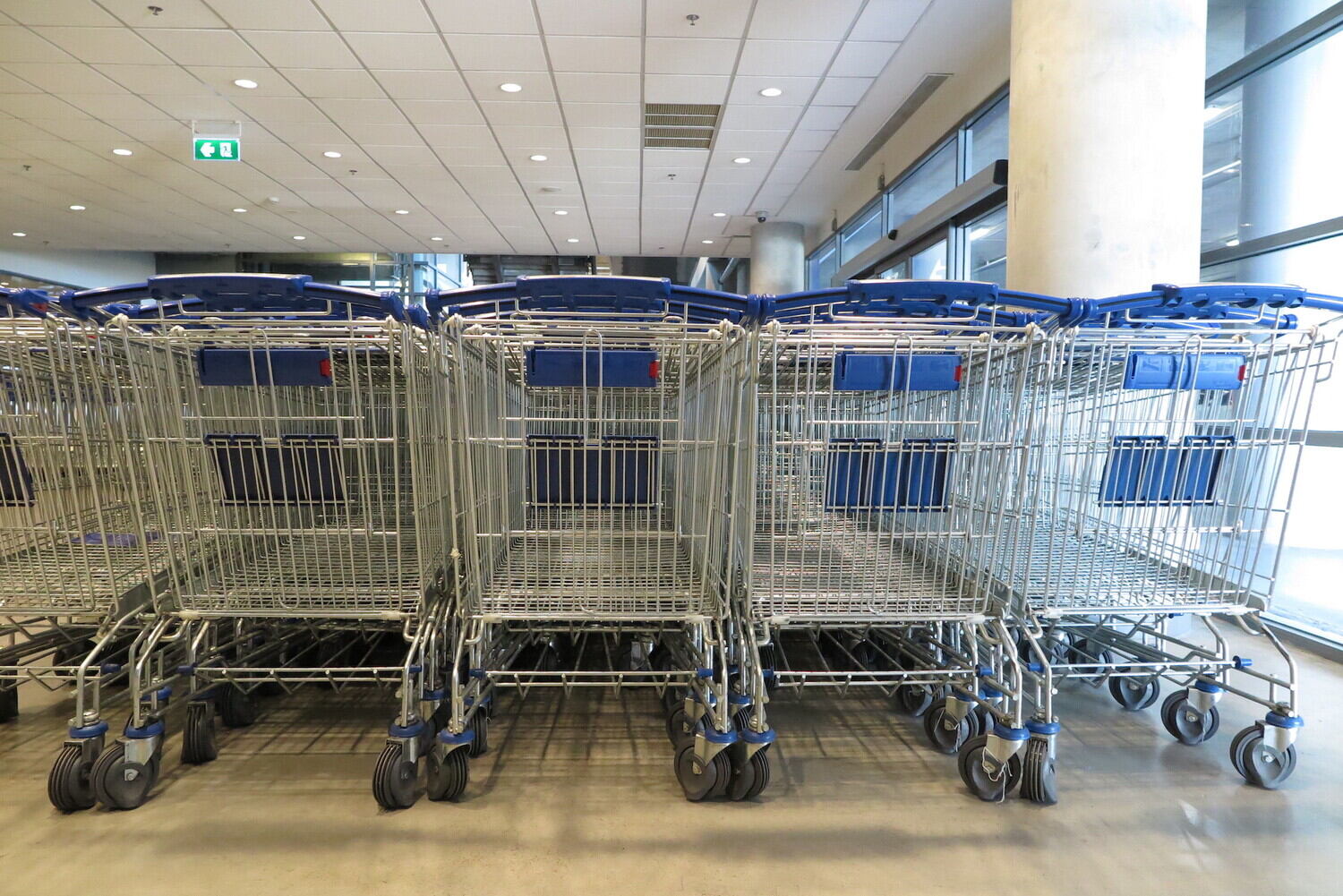

Articles
How To Store Carts
Modified: December 7, 2023
Learn how to store your articles and maintain their quality with our step-by-step guide. From organization tips to proper storage techniques, we've got you covered!
(Many of the links in this article redirect to a specific reviewed product. Your purchase of these products through affiliate links helps to generate commission for Storables.com, at no extra cost. Learn more)
Introduction
Proper cart storage is essential for maintaining the longevity and functionality of your carts. Whether you own a grocery store, a warehouse, or a retail establishment, storing carts correctly can greatly benefit your business and enhance customer satisfaction. In this article, we will explore the various benefits of proper cart storage and provide you with valuable tips on how to store your carts effectively.
By implementing the right storage practices, you can ensure that your carts remain in optimal condition for extended periods, saving you both time and money in the long run. Additionally, proper cart storage promotes a safe and organized working environment, making it easier for employees to retrieve and utilize the carts efficiently.
Join us as we delve into the world of cart storage and discover the best practices to keep your carts in excellent shape. From selecting an appropriate storage area to ensuring cart cleanliness and implementing correct stacking techniques, we will cover every aspect of cart storage that you need to know. So, let’s dive in and learn how to store carts the right way.
Key Takeaways:
- Proper cart storage offers benefits such as extended lifespan, improved durability, and enhanced employee safety. It also contributes to efficient space utilization and a positive customer experience.
- Selecting an appropriate storage area, preparing carts for storage, and implementing correct stacking techniques are crucial for maintaining cart longevity and functionality. Prioritizing cart cleanliness and security measures is essential for a safe and organized storage environment.
Read more: How To Store A Cart
Benefits of Proper Cart Storage
Proper cart storage offers several significant benefits for businesses of all sizes. Here are some of the key advantages of implementing effective cart storage practices:
- Extended Lifespan: When carts are stored properly, they are protected from damage caused by harsh weather conditions, excessive use, and accidents. This extends the lifespan of the carts, reducing the need for frequent replacements and saving you money in the long run.
- Improved Cart Durability: By storing carts in a designated area, away from potential hazards, you can prevent damage to the wheels, handles, and other structural components. This helps to maintain the overall durability of the carts, ensuring they can withstand heavy usage over time.
- Enhanced Employee Safety: Proper cart storage promotes a safe working environment for your employees. Storing the carts in an organized manner reduces the risk of accidents, such as carts tipping over or obstacles obstructing walkways. This minimizes the chances of injuries and avoids potential liability issues.
- Efficient Space Utilization: An organized cart storage system allows you to maximize the use of your available space. By stacking carts properly and utilizing vertical space effectively, you can store a larger number of carts in a smaller area, freeing up valuable floor space for other purposes.
- Improved Customer Experience: When carts are stored properly, they are readily available for customers to use. This saves them time and frustration while enhancing their overall shopping experience. Easy access to carts contributes to a more positive customer perception of your business.
- Streamlined Operations: Proper cart storage ensures that carts are easily accessible for employees when they need to restock merchandise, rearrange displays, or assist customers. This streamlines daily operations and helps employees work more efficiently, contributing to improved productivity.
By implementing effective cart storage practices, you can reap these benefits and create a smoother and more efficient shopping experience for both your employees and customers. Now that we understand the advantages of proper cart storage, let’s explore the key considerations when selecting an appropriate storage area.
Selecting an Appropriate Storage Area
Choosing the right storage area for your carts is crucial to ensure their longevity and accessibility. Consider the following factors when selecting an appropriate cart storage area:
- Indoor vs. Outdoor: Determine whether your storage area will be indoors or outdoors. Indoor storage provides better protection from the elements, reducing the risk of cart damage due to extreme weather conditions. If outdoor storage is the only option, consider using cart covers or shelters to shield them from rain, sun, and other environmental factors.
- Accessibility: Select a storage area that is easily accessible for both employees and customers. Ideally, it should be located near an entrance or exit to facilitate quick retrieval and return of the carts. This helps to maintain a smooth flow of cart usage and improves operational efficiency.
- Adequate Space: Ensure that the storage area has enough space to accommodate the number of carts you typically use. Consider factors such as the size and dimensions of the carts, as well as any additional equipment or materials that need to be stored alongside them. Avoid overcrowding the area, as it can lead to difficulties in maneuvering and retrieving the carts.
- Safety Considerations: Prioritize safety when selecting a storage area. Ensure that the area is free from potential hazards such as uneven surfaces, sharp objects, or obstructions that could cause accidents or damage to the carts. Proper lighting and clear signage can also contribute to a safer storage environment.
- Security Measures: Protect your carts from theft or unauthorized use by implementing appropriate security measures. Consider using locking mechanisms or surveillance systems to deter theft and ensure that only authorized personnel have access to the storage area.
By carefully considering these factors, you can select an appropriate storage area that promotes the longevity and accessibility of your carts. Once you have chosen the storage area, the next step is to prepare the carts for storage, which we will explore in the following section.
Preparing Carts for Storage
Properly preparing your carts for storage is essential to ensure their protection and functionality during the storage period. Follow these steps to prepare your carts for storage:
- Remove any debris: Before storing the carts, remove any debris or loose items that may have accumulated in them. This includes papers, wrappers, and any other items that can potentially damage the cart or become a breeding ground for pests.
- Inspect for damaged parts: Thoroughly inspect each cart for any damaged parts, such as bent frames, broken wheel casters, or loose handles. Address these issues before placing the carts in storage to prevent further damage and ensure they are ready for use once retrieved.
- Disinfect and clean: Clean the carts using a mild detergent or disinfectant to remove any dirt, grime, or germs. Pay special attention to areas that come into direct contact with food or are prone to accumulation of bacteria. Wipe down the handles, seat areas, and wheels to maintain proper hygiene standards.
- Inspect wheel condition: Check the condition of the wheels and ensure they are clean and free from debris or excessive wear. Lubricate the wheel bearings if necessary to ensure smooth rolling and prevent damage to the carts or storage area.
- Secure loose items: Secure any loose accessories, such as trays or baskets, to prevent them from getting damaged or lost during storage. Store these items alongside the carts or in designated compartments to keep them organized and readily available when needed.
By following these steps, you can ensure that your carts are properly prepared for storage, minimizing the risk of damage and ensuring their functionality during the storage period. In the next section, we will delve into the importance of cart cleanliness and how to maintain their hygiene during storage.
Ensuring Cart Cleanliness
Maintaining the cleanliness of your carts is essential for both hygiene and customer satisfaction. Proper cleanliness practices during cart storage help prevent the buildup of dirt, germs, and bacteria. Here are some tips to ensure cart cleanliness:
- Regular cleaning schedule: Establish a regular cleaning schedule for your carts, even during storage. Depending on the frequency of cart usage and the nature of your business, you may need to clean them daily, weekly, or monthly. This helps prevent dirt and grime from accumulating and ensures that the carts are ready for use when needed.
- Use appropriate cleaning agents: Select cleaning agents that are suitable for the materials used in your carts. Avoid harsh chemicals that can damage the carts or leave behind residue. Use mild detergents or disinfectants that are effective against germs and bacteria but gentle on the cart surfaces.
- Pay attention to high-touch areas: Focus on cleaning high-touch areas of the carts, such as handles and seat areas, where customers come into direct contact. These areas are more prone to the transfer of germs and bacteria. Regularly sanitize and wipe down these areas to ensure proper hygiene.
- Inspect for spills or stains: Check for any spills or stains on the carts and address them promptly. Use appropriate cleaning methods or stain removers to remove any visible marks. Stains not only affect the appearance of the carts but can also harbor bacteria and contribute to unpleasant odors.
- Train employees on cleaning procedures: Provide proper training to your employees on cleaning procedures for the carts. Ensure they understand the importance of maintaining cleanliness standards and follow the recommended cleaning guidelines. This helps to maintain consistency in cart cleanliness throughout your business.
By prioritizing cart cleanliness during storage, you promote a hygienic environment for both your employees and customers. Regular cleaning practices ensure that the carts are always ready for use and contribute to a positive shopping experience. In the next section, we will explore the correct techniques for cart stacking during storage.
When storing carts, make sure to clean them thoroughly to remove any debris or spills. Store them in a dry, well-ventilated area to prevent rust and mold growth. Cover them with a tarp or cloth to protect them from dust and dirt.
Read more: How To Store Golf Cart For Winter
Correct Cart Stacking Techniques
Stacking carts properly during storage is vital to optimize space utilization, prevent damage, and ensure easy accessibility. Here are some important techniques to follow when stacking your carts:
- Align carts evenly: Ensure that the carts are aligned evenly when stacking them. This helps maintain stability and prevents carts from shifting or toppling over. Check that the wheels and handles are lined up properly before adding more carts to the stack.
- Alternate the direction: Alternate the direction of each cart when stacking them. This helps distribute the weight evenly and provides better stability. By alternating the direction, you create a more secure and balanced stack of carts.
- Follow weight limits: Be aware of the weight limits specified by the manufacturer for each cart. Do not exceed these limits when stacking carts. Overloading can lead to structural damage or instability, compromising the functionality and safety of the carts.
- Use stacking bars or dividers: Utilize stacking bars or dividers to separate individual stacks of carts. These accessories help maintain the stability of each row and prevent carts from collapsing into one another. Stacking bars also make it easier to access and retrieve specific stacks of carts.
- Secure the top carts: Secure the top carts in the stack to prevent them from sliding off or getting dislodged during storage. You can use straps, bungee cords, or other securing mechanisms to keep the carts in place and maintain overall stack stability.
By following these stacking techniques, you can optimize the use of available space, reduce the risk of cart damage, and make it easier to retrieve carts when needed. Next, let’s explore the importance of securing carts in storage and how to ensure their safety.
Securing Carts in Storage
Securing carts properly in storage is essential to prevent accidents, damage, and unauthorized use. Here are some tips to ensure the safety and security of your carts:
- Locking mechanism: Implement a locking mechanism to secure the carts in storage. This can be a simple lock system that prevents the carts from rolling or a more advanced locking mechanism that requires a key or access code to release the carts.
- Assign responsibility: Assign specific personnel responsible for inspecting and securing the carts in storage. This ensures accountability and reduces the risk of neglect or oversight in properly securing the carts.
- Surveillance system: Install a surveillance system, such as cameras or motion sensors, to monitor the storage area. This deters theft and unauthorized access to the carts. Additionally, having a surveillance system in place can help identify any potential issues or theft incidents that may occur.
- Control access: Limit access to the cart storage area to authorized personnel only. This can be achieved by using key cards, access codes, or restricted areas. By controlling access, you reduce the chances of unauthorized individuals tampering with or stealing the carts.
- Regular inspections: Conduct regular inspections of the storage area to ensure the carts remain properly secured and in good condition. This includes checking the locking mechanisms, inspecting for any signs of damage, and addressing any issues promptly.
By implementing these security measures, you can protect your carts from theft, unauthorized use, and damage. Ensure that the carts are securely stored to maintain a safe and organized environment. In the next section, we will discuss the importance of regular maintenance and inspection to keep your carts in optimal condition during storage.
Regular Maintenance and Inspection
Regular maintenance and inspection of your carts is crucial to ensure their optimal performance and longevity. Here are some important steps to follow for effective maintenance and inspection:
- Establish a maintenance schedule: Create a regular maintenance schedule for your carts, including routine inspections, cleaning, and any necessary repairs. This helps to identify and address any issues before they worsen and ensures that the carts remain in good working condition.
- Inspect for damage: Regularly inspect your carts for any signs of damage, such as bent frames, loose wheels, or broken handles. Address these issues promptly to prevent further damage and ensure the carts are safe to use.
- Clean and sanitize: Clean the carts regularly, even during storage, to maintain cleanliness and hygiene. Use appropriate cleaning agents and follow proper cleaning procedures to ensure the carts are free from dirt, germs, and bacteria.
- Check wheel condition: Inspect the condition of the wheels regularly and ensure they are clean, well-lubricated, and in good working order. Replace any worn-out or damaged wheels to ensure smooth rolling and avoid potential accidents during use.
- Tighten loose parts: Check for any loose parts, such as handles or screws, and tighten them as needed. Loose parts can compromise the functionality and stability of the carts, so it’s important to address them before using or storing the carts.
- Monitor cart performance: Pay attention to how the carts perform during use. If you notice any issues, such as wheels not rolling smoothly or handles becoming loose, take immediate action to rectify the problems. Regular monitoring helps prevent larger issues from arising.
By conducting regular maintenance and inspections, you can identify and address any issues with your carts, ensuring they remain in optimal condition during storage. This not only prolongs the lifespan of the carts but also contributes to a safer working environment. In the next section, we will explore different retrieval methods from storage.
Retrieval Methods from Storage
Once your carts are stored properly, it’s important to have efficient retrieval methods in place to ensure easy access and seamless operations. Here are some common retrieval methods you can consider:
- FIFO (First In, First Out): Implementing the FIFO method involves organizing your storage area so that the oldest carts are placed at the front of the storage area. This ensures that the carts are used in the order they were stored, minimizing the chances of carts being left unused for extended periods.
- Zoning: Divide your storage area into different zones based on cart types, sizes, or departmental needs. This allows for efficient organization and faster retrieval of specific carts when required, reducing the time and effort spent on locating the right carts.
- Labeling: Use clear and visible labels or signage to indicate the contents or purpose of each stack of carts. This makes it easier for employees to find the carts they need quickly and accurately.
- Barcode or RFID: Implementing a barcode or RFID (Radio Frequency Identification) system enables you to track and identify each cart individually. This technology allows for efficient and accurate retrieval of specific carts by simply scanning the unique code or tag associated with each cart.
- Automated Retrieval System: For larger operations or high-volume storage requirements, consider investing in an automated retrieval system. These systems utilize robotics or conveyor systems to retrieve and deliver the carts to designated areas, streamlining the entire process and minimizing manual labor.
By implementing these retrieval methods, you can ensure that carts are retrieved quickly and efficiently, contributing to smoother operations and improved productivity. Choose a method that best suits the size and needs of your business. Now, let’s conclude our discussion on cart storage.
Conclusion
Proper cart storage is a crucial aspect of maintaining the longevity, functionality, and safety of your carts. By implementing effective storage practices, you can reap numerous benefits for your business. From extended lifespan and improved durability of carts to enhanced employee safety and streamlined operations, the advantages are plentiful.
To ensure proper cart storage, it is important to select an appropriate storage area that is easily accessible, provides adequate space, and ensures the safety and security of your carts. Preparing the carts for storage by removing debris, inspecting for damage, and cleaning them is essential for maintaining their condition during storage.
Ensuring cart cleanliness and implementing correct cart stacking techniques contribute to a hygienic environment, optimized space utilization, and easy retrieval of carts. Securing the carts in storage through locking mechanisms, controlled access, and regular inspections helps prevent theft, unauthorized use, and damage.
Regular maintenance and inspection, including cleaning, checking for damage, and addressing any issues promptly, are crucial to keeping your carts in optimal condition during storage. Efficient retrieval methods, such as FIFO, zoning, labeling, or automated systems, enable seamless and organized access to your stored carts.
By following these practices, you can enhance the functionality and lifespan of your carts, improve employee productivity, and provide a positive shopping experience for your customers. Prioritizing proper cart storage demonstrates your commitment to maintaining a well-organized and efficient operation.
Remember, proper cart storage is an ongoing process that requires regular attention and maintenance. By dedicating the necessary time and resources to store your carts correctly, you can ensure their longevity, protect your investment, and contribute to the overall success of your business.
Frequently Asked Questions about How To Store Carts
Was this page helpful?
At Storables.com, we guarantee accurate and reliable information. Our content, validated by Expert Board Contributors, is crafted following stringent Editorial Policies. We're committed to providing you with well-researched, expert-backed insights for all your informational needs.














0 thoughts on “How To Store Carts”